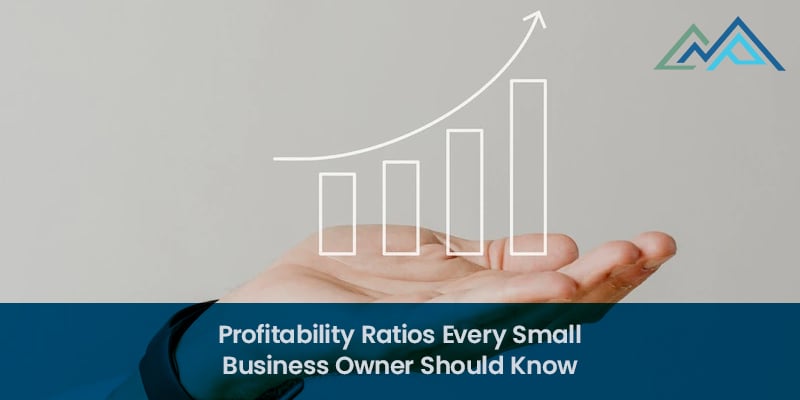Owning a small business is a balancing act. If you’re a business owner, you’ve got to balance your operating expenses and revenue against the demands of shareholders, all while trying to generate a profit for your business. For anybody who’s not an accountant, it can be challenging to keep an eye on profits while you’re wearing multiple hats each day.

At CMP, a Utah CPA firm, we believe strongly in helping small business owners succeed. One question we get asked a lot is this:
What are profitability ratios, and how can I use them in my business?
We’re always happy to answer that question because we know that understanding profitability ratios is essential to the success of any small business. Here’s what you need to know.
What is a Profitability Ratio?
Let’s start with the basics. A profitability ratio is one of several financial ratios that can be used in any business to evaluate that business’s ability to generate profits relative to other key figures, including the following:
- Sales revenue
- Operating costs
- Balance sheet assets
- Shareholder’s equity over time
Each number used when calculating a profitability ratio should use data from a chosen point in time. A profitability ratio can be compared with another metric, an efficiency ratio. An efficiency ratio illustrates how well a business uses its assets to generate income.
When you calculate profitability ratios, you can use them internally to examine your operations and profit-generating ability. They are particularly useful when compared with your company’s historical performance. You may also choose to use them to evaluate your profitability when compared to other companies in your industry or the industry average.
Understanding your profitability ratios is just the beginning. Have you considered how a 401(k) profit-sharing plan could further enhance your company's financial health? As a small business owner, implementing a profit-sharing plan can be a strategic move that rewards your employees and boosts your bottom line. Learn the ins and outs of 401(k) profit sharing plan and discover how this retirement plan option can benefit both you and your team. Equip yourself with the knowledge to make informed decisions that drive profitability and employee satisfaction
Why Do Profitability Ratios Matter to Small Business Owners?
Let’s talk about why you should care about profit ratios and how they can help you and your business. Profitability ratios provide the four key benefits as follows:
- They can help you compare your business to other companies. It can be helpful to know how your company stacks up against others in your industry, but comparing revenue alone won’t give you a complete picture of how you’re doing. Using profitability ratios allows you to get a broad view of your business efficiency and makes it possible for you to compare yourself with large business enterprises as well as smaller companies—something that would be impossible if you were comparing revenue alone.
- They can reveal problems with your business. Profitability ratios have a way of revealing specific issues because they can be used to compare your profits with various aspects of your business. That’s not the case with a balance sheet, which is essential but provides a broad overview that won’t help you examine your business in depth. Using the profitability ratios that we’ll explain in the next section can help you evaluate issues such as overspending and find solutions.
- They provide useful information to potential investors. Investors love to see a good profitability ratio. A favorable ratio can encourage additional investments in your business. New investors will also be happy to see that your business is generating good profits because it tells them that the business is being run smoothly and efficiently.
- They’re a good benchmark for seasonal businesses. Profitability ratios can be extremely useful if your business relies on seasonal income. You can use them to compare profits year over year or season over season. The results of your calculations can then be used to allocate your resources and make budget decisions to improve your performance during your peak sales seasons.
Understanding and calculating your company’s profitability and financial ratios can ensure that your business is operating smoothly and make it easy for you to increase your profits.
Different Types of Profitability Ratios
There are five types of profitability ratios that every small business owner should know. In this section, we’ll explain each and tell you how to calculate them.
Gross Profit Margin
The Gross Profit Margin is the profitability ratio that is most often used by small businesses. It expresses profitability as a percentage by subtracting the cost of goods sold (COGS) from your total sales and dividing the result by your total sales. Here is the formula:
Gross Profit Margin = (Total Net Sales – COGS) ÷ Total Net Sales
It’s important to use your net sales, which you can calculate by taking your gross sales and subtracting discounts, returns, and allowances, to get a true picture of your business’s profitability.
You can find the numbers you need to calculate your Gross Profit Margin on your company’s income statement. As a rule, a high Gross Profit Margin is a good sign because it indicates that your company is operating at a high degree of efficiency.
Operating Profit Margin
The Operating Profit Margin, which may also be referred to as earnings before interest and tax, or EBIT for short, is also useful. This ratio looks at your operating profit as a percentage of your total revenue.
Your company's Operating Profit Margin is useful for assessing how well your business could cope with a slowdown in revenue because it will tell you whether your profitability is high enough to allow you to pay your operating expenses in slow times.
As you might expect, the Operating Profit Margin is particularly useful for seasonal businesses because it can help business owners evaluate their profitability for off-season periods when profits are likely to be at their lowest, but there’s still a need to pay for operating expenses.
You can calculate your Operating Profit Margin by using this formula:
Operating Profit Margin = Operating Profit ÷ Revenue
Your operating profit is calculated by taking your gross profit and subtracting COGS, the cost of salaries, benefits, rent and other business expenses, depreciation, and amortization. The resulting percentage will tell you how much money you are earning.
A high Operating Profit Margin indicates that your company is successfully managing expenses to maximize profitability.
Understanding your operating profit is key, but when buying a business, it's vital to ask the right questions. Make sure you’re thorough by exploring the questions to ask when buying a business to cover all your bases and ensure a smart investment.
Net Profit Margin
If you want to measure how much profit you’re generating as a percentage of revenue, then the profitability ratio to use is the Net Profit Margin ratio, also referred to as a Simply Net Margin.
This profitability ratio expresses the ratio of net profits to revenues for your company. It is typically expressed as a percentage but may sometimes be expressed as a decimal. Another way to look at it is to say that the Net Profit Margin tells you how much of each dollar of your revenue translates into profit.
The Net Profit Margin is a useful tool to measure how well a company is managing its overhead and expenses to maximize profitability. It is also a metric that can help you (and potential investors) assess the financial health of your company.
You can use the following formula to calculate the Net Profit Margin:
(Net Income ÷ Revenue) X 100
You can calculate your net income by taking your total revenue and subtracting the following items:
- Cost of Goods Sold (COGS)
- Operating and other expenses
- Interest
- Taxes
You can also find your net income by looking at the bottom of your income statement.
Return on Assets
A company’s Return on Assets or ROA is an indication of how profitable the company is related to its total assets.
To calculate your company’s ROA, you’ll need your net income and average assets. You can use your ROA to understand whether you’re using your company assets efficiently to generate profits. A high ROA is an indication that a company is managing its balance sheet efficiently, while a low ROA means there’s room to improve the efficiency of your operations.
You can calculate your ROA using this formula:
Return on Assets = Net Income ÷ Total Assets
We explained how to calculate net income in the explanation of Net Profit Margin, and you can use the same number here. You can find your Total Assets listed on your balance sheet.
The ROA is most useful when comparing your company to others in the same industry because you’ll share the same asset base.
Return on Equity
Our final profitability ratio to consider is Return on Equity or ROE. ROE is a way of measuring your company’s financial performance based on shareholders’ equity, which is equal to your company assets minus your liabilities. This ratio is also referred to as a Return on Net Assets.
ROE is used to gauge your company’s profitability and efficiency in generating profits. A high ROE indicates that your company’s management is using its equity financing to generate growth and income.
You can calculate your company’s ROE using this formula:
Return on Equity = Net Profits ÷ Average Shareholders’ Equity
The Shareholders’ Equity (SE) can be found on your balance sheet. You can calculate the average by taking the SE at the beginning of a period and the SE at the end of a period, adding them together, and dividing by two.
ROEs are not comparable across industries but can be useful as a comparison with other companies in the same sector or industry.
How Can You Improve Your Profitability Ratios?
Profitability ratios are useful for determining how effectively and efficiently your company is generating profits. What happens if you identify a current ratio that isn’t as favorable as you want it to be? Here are some practical steps you can take to improve your profitability ratios.
- Review your costs. Since the cost of goods sold is a factor in several of the ratios we’ve explained here, it makes sense that reviewing your production costs and other expenses is the place to start if you want to improve your profitability ratios. Examine how much you’re spending and where you think you can save money.
- Negotiate with suppliers. It’s common for small businesses to pay more than necessary for raw materials and supplies. Ask your largest suppliers if they will offer you a price reduction or give you a discount for prompt payment. You might also consider buying in bulk to save money.
- Cut waste from your expenses. Also, work to bring your overhead expenses down. Many small businesses have downsized with employees working from home. You could also negotiate better rates on your utilities or sublet office space you’re not using.
- Examine your pricing. Another common issue for small businesses is not charging enough for products and services. Review your margins and increase your prices as needed to maximize your profits.
- Sell more to your most profitable customers. The Pareto Principle says that 80% of a company’s profits come from 20% of its customers. You can increase profits by offering upsells and deals to your most important customers to garner more profits.
- Expand your market. Consider adding new products or advertising to a new audience to sell more and increase your profits.
- Improve your efficiency. Reviewing your business operations and processes can help you identify areas where you’re wasting time or money. You can address these issues with employee training, refined processes, or even automation.
These 7 steps can help you improve any current ratio and earn more money for your investors.
Start Using Profitability Ratios in Your Small Business
Calculating the five profitability ratios we’ve explained here can help you understand how efficiently your business generates profits and identify areas for improvement. When you improve your profitability ratios, your business will be more profitable, and it will be easy for you to attract new investors and grow your company.
Are you ready to start using profitability ratios in your small business? CMP is here to help you. We provide a variety of accounting services ranging from income tax services to outsourced CFO solutions to optimize your profitability and maximize your cash flow to help your business grow. 

















